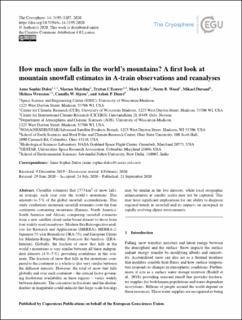How much snow falls in the world's mountains? A first look at mountain snowfall estimates in A-train observations and reanalyses
| dc.contributor.author | Daloz, Anne Sophie | |
| dc.contributor.author | Mateling, Marian | |
| dc.contributor.author | L'Ecuyer, Tristan | |
| dc.contributor.author | Kulie, Mark | |
| dc.contributor.author | Wood, Norman B. | |
| dc.contributor.author | Durand, Mikael | |
| dc.contributor.author | Wrzesien, Melissa | |
| dc.contributor.author | Stjern, Camilla Weum | |
| dc.contributor.author | Dimri, Ashok P. | |
| dc.date.accessioned | 2021-07-14T12:09:55Z | |
| dc.date.available | 2021-07-14T12:09:55Z | |
| dc.date.created | 2021-02-26T09:13:19Z | |
| dc.date.issued | 2020 | |
| dc.identifier.citation | The Cryosphere. 2020, 14 (9), 3195-3207. | en_US |
| dc.identifier.issn | 1994-0416 | |
| dc.identifier.uri | https://hdl.handle.net/11250/2764420 | |
| dc.description.abstract | CloudSat estimates that 1773 km3 of snow falls, on average, each year over the world's mountains. This amounts to 5 % of the global snowfall accumulations. This study synthetizes mountain snowfall estimates over the four continents containing mountains (Eurasia, North America, South America and Africa), comparing snowfall estimates from a new satellite cloud-radar-based dataset to those from four widely used reanalyses: Modern-Era Retrospective analysis for Research and Applications (MERRA), MERRA-2, Japanese 55-year Reanalysis (JRA-55), and European Center for Medium-Range Weather Forecasts Re-Analysis (ERA-Interim). Globally, the fraction of snow that falls in the world's mountains is very similar between all these independent datasets (4 %–5 %), providing confidence in this estimate. The fraction of snow that falls in the mountains compared to the continent as a whole is also very similar between the different datasets. However, the total of snow that falls globally and over each continent – the critical factor governing freshwater availability in these regions – varies widely between datasets. The consensus in fractions and the dissimilarities in magnitude could indicate that large-scale forcings may be similar in the five datasets, while local orographic enhancements at smaller scales may not be captured. This may have significant implications for our ability to diagnose regional trends in snowfall and its impacts on snowpack in rapidly evolving alpine environments. | en_US |
| dc.language.iso | eng | en_US |
| dc.publisher | EGU | en_US |
| dc.rights | Navngivelse 4.0 Internasjonal | * |
| dc.rights.uri | http://creativecommons.org/licenses/by/4.0/deed.no | * |
| dc.title | How much snow falls in the world's mountains? A first look at mountain snowfall estimates in A-train observations and reanalyses | en_US |
| dc.type | Journal article | en_US |
| dc.type | Peer reviewed | en_US |
| dc.description.version | publishedVersion | en_US |
| dc.source.pagenumber | 3195-3207 | en_US |
| dc.source.volume | 14 | en_US |
| dc.source.journal | The Cryosphere | en_US |
| dc.source.issue | 9 | en_US |
| dc.identifier.doi | 10.5194/tc-14-3195-2020 | |
| dc.identifier.cristin | 1893904 | |
| cristin.ispublished | true | |
| cristin.fulltext | original | |
| cristin.qualitycode | 2 |
Files in this item
This item appears in the following Collection(s)
-
Journal articles [468]

